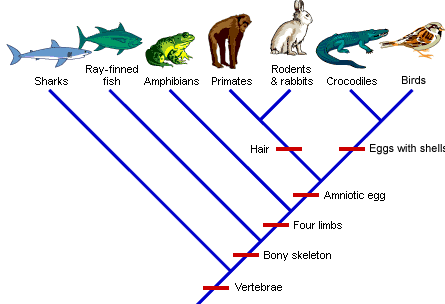
Give an example of one organism from each kingdom.
Archaea - Thermus aquaticus
Bacteria - E. coli
Protist - amoeba
Fungi - mushroom
Plants - apple tree
Animals - humans
What is binomial nomenclature? Explain with an example.
A two part scientific naming system that uses the genus and species taxons to give an organism a name.
The genus must be capitalized and the species must be lowercase. The name must be underlined if handwritten or italicized if typed.
Example: Homo sapiens
Which are more closely related, animals in the same family or same order?
family
What is an invasive species? Why are they a concern?
- are organisms that successfully establish, and then thrive, in new environments where they did not evolve
- they can:
Give five good information points on what antimicrobial resistance is and why we should be concerned about it.
- Antibiotics are medicines used to prevent and treat bacterial infections -eg. Penicillin
- some bacteria have become resistant to the antibiotics that we have been using
- they do this by random mutation or exchanging genes with other species of bacteria
- some eg. MRSA and VRE have become resistant to multiple antibiotics
- Antibiotic resistance is now a worldwide public health problem. Antibiotics are less effective at treating serious infections. Someone with an infection that is resistant to a certain medicine can pass that resistant infection to other people, including family members, and coworkers. In this way, a hard-to-treat infectious disease can threaten whole communities. This can be especially dangerous for young children, the elderly, and people with weakened immune systems (e.g. individuals already in the hospital or chronically ill) who are more vulnerable.
- we can reduce the spread of antibiotic resistance by:
What tissue comprises the veins of a leaf?
vascular tissue - xylem and phloem
What is the endodermis?
- ring of cells that surround the vascular tissue in a plant root - filters material travelling to the centre of the root
In which cells does the most photosynthesis occur?
mesophyll cells (palisade)
Which organelle is responsible for photosynthesis?
What is the equation for photosynthesis?
chloroplast
carbon dioxide + water + sunlight produces oxygen and glucose
What type of plant is this?

dicot - can determine from the ring of vascular bundles around the edge
Where does the blood go after it leaves the ventricles?
right ventricle sends blood to the lungs through the pulmonary arteries
left ventricle sends blood to the body through the aorta
What is the function of bile?
- emulsify fats
- breaks large fat globules into smaller globules
- this increases the surface area for the enzymes (lipases) to act
- this speeds up digestion
What is the difference between physical (mechanical) and chemical digestion?
physical digestion - breaking food down into smaller pieces by mechanical methods eg. chewing
chemical digestion - breaking food into simpler molecules by chemical means eg. amylase breaks starch to maltose
A patient has a vital capacity of 5000 mL. Their inspiratory reserve volume is measured at 2700 mL and their expiratory reserve volume is 1500 mL. What is their tidal volume?
800 mL
Describe in detail, blood flow through the heart.
1. Deoxygenated blood from the body collects in veins
2. Vena cava
3. Right atrium
4. Tricuspid atrioventricular valve
5. Right ventricle
6. Semi-lunar valve
7. Pulmonary arteries
8. Lungs (gas exchange occurs)
9. Pulmonary veins
10. Left atrium
11. Bicuspid atrioventricular valve
12. Left ventricle
13. Semi-lunar valve
14. Aorta
15. Oxygenated blood is sent to the body
Two pea plants were mated many times. They produced 3423 tall plants and 1134 dwarf plants. What were the genotypes of the parents?
- the offspring were produced in a ratio of 3:1 (dominant: recessive) therefore the parents were likely both heterozygous (Tt and Tt)
In tomato plants, the trait for round tomatoes (R) is dominant to pear-shaped tomatoes (r). What are the genotypes of each of the following?
a) a homozygous plant with round tomatoes
b) a plant with pear shaped tomatoes
c) the offspring of a cross between the plants in a) and b)
a) RR
b) rr
c) Rr
Brown eyes are dominant to blue eyes. A blue eyed woman marries a heterozygous brown eyed man. Is there a possibility that they will have a blue eyed child?
They have a 50% chance of having a blue eyed child
Hemophilia is a recessive sex-linked trait. A man with a normal genotype marries a woman who is a carrier of haemophilia. Is it possible that any of their daughters will have haemophilia? Any of their sons?
None of their daughters will have hemophilia however, ½ of their sons will.
In humans, right-handedness (R) is dominant over left-handedness (r) and brown eyes (B) are dominant over blue eyes (b). A right handed, blue-eyed man whose father was left-handed marries a left-handed, brown-eyed woman from a family in which all the members have been brown-eyed for several generations. What offspring may be expected from this marriage, as to the two traits mentioned?
They will be 50% RrBb (right handed and Brown eyed) and 50% rrBb (left handed and Brown eyed)
Which individuals are the most "fit" in an evolutionary sense?
- those that can produce the most offspring that survive to pass on their genes

Is the purple coloured area considered a clad?
yes
Which is more closely related, the bird and the primate or the shark and the primate?

bird and primate

Could the lizards and snakes be added to the purple clad?
Not unless they also included the crocodile. A clad must contain all descendants of a common ancestor.

Are the birds more closely related to the lizards or snakes?
neither - equally related